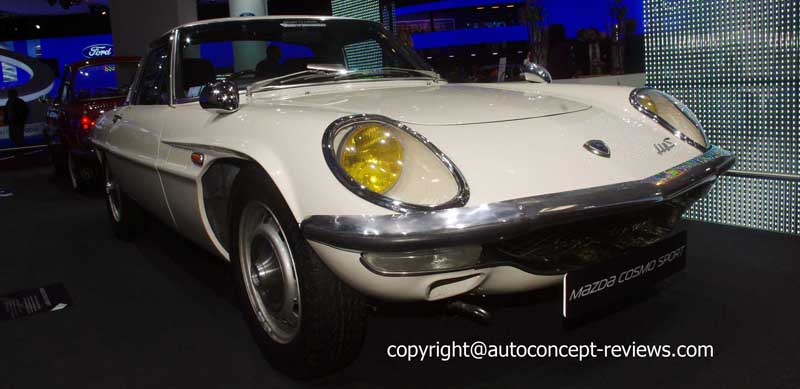Mazda Cosmo 110 Twin Rotary Piston Engine 1963 - 1972The Mazda Cosmo prototype was introduced at the 1963 Tokyo Motor Show. The Mazda Cosmo was introduced in production in 1966. It is presented as the first production automobile equipped with a twin rotary piston engine. The Mazda Cosmo Serie I was produced at 343 examples between 1967 and 1968, while the Serie II was made at 1.176 examples between 1968 and 1972 (according to Bonhams 2015) for a total of 1519 units.
The Mazda Serie I proposed a 110 hp at 7.000 rpm engine while the Serie II was propelled by a 128 hp engine with a five-speed gearbox allowing a top speed of 120 mph. Mazda's rotary engine development history began in 1961. Emerging from the confusion of the postwar period, Japan's automotive industry was starting to expand. There were clear signs that competition was intensifying amongst car makers, and the pace of the industry’s reorganization and capital tie-ups increased rapidly. Within this environment, a late starter such as Mazda faced tough decisions as to how best to display its distinctive character if it were to maintain its independence. So, early discussions within the industry as to the potential of the rotary engine as dream technology for the future presented a golden opportunity.
Tsuneji Matsuda, then president of Toyo Kogyo (which became Mazda), paid a personal visit to the headquarters of NSU Motorenwerke AG in West Germany, developer of the Wankel engine, where he signed a technical cooperation contract. Effectively gambling Mazda's corporate identity on one major engineering challenge, Matsuda-san's aim was to widely commercialise an unknown new technology, the mass-production of rotary-engined vehicles simultaneously establishing the company's global credentials as a unique, independent car maker boasting the very highest levels of technological prowess. However, the reality of rotary engine development was to prove extremely demanding. The team of 47 engineers in Mazda’s rotary engine research department faced innumerable challenges of considerable complexity; not least of which was the elimination of the chatter marks -also known as 'the devil’s nail marks'- etched on the inside walls of the rotor housing as the result of friction caused by the rotor turning at high speed. Refusing to compromise, the company's engineers doggedly resolved one technological challenge after another until, finally, on May 30th 1967, Mazda unveiled the Cosmo Sport - the world's first two-rotor rotary-engined production car and a new step forward in automotive history.
The following year, the Cosmo Sport competed in the 1968 Marathon De La Route-an 84-hour endurance race staged at Germany’s famed Nürburgring. Completing the 3.5 day non-stop race and taking fourth place overall, Mazda's unique machine proved that the rotary engine not only delivered excellent performance but was also highly durable. Wallpapers for Mazda Cosmo 110 Twin Rotary Piston Engine 1963 - 1972 (click on image to enlarge)
|
|||||||||||||||||||
|---|---|---|---|---|---|---|---|---|---|---|---|---|---|---|---|---|---|---|---|
|
||||||||||||||




















